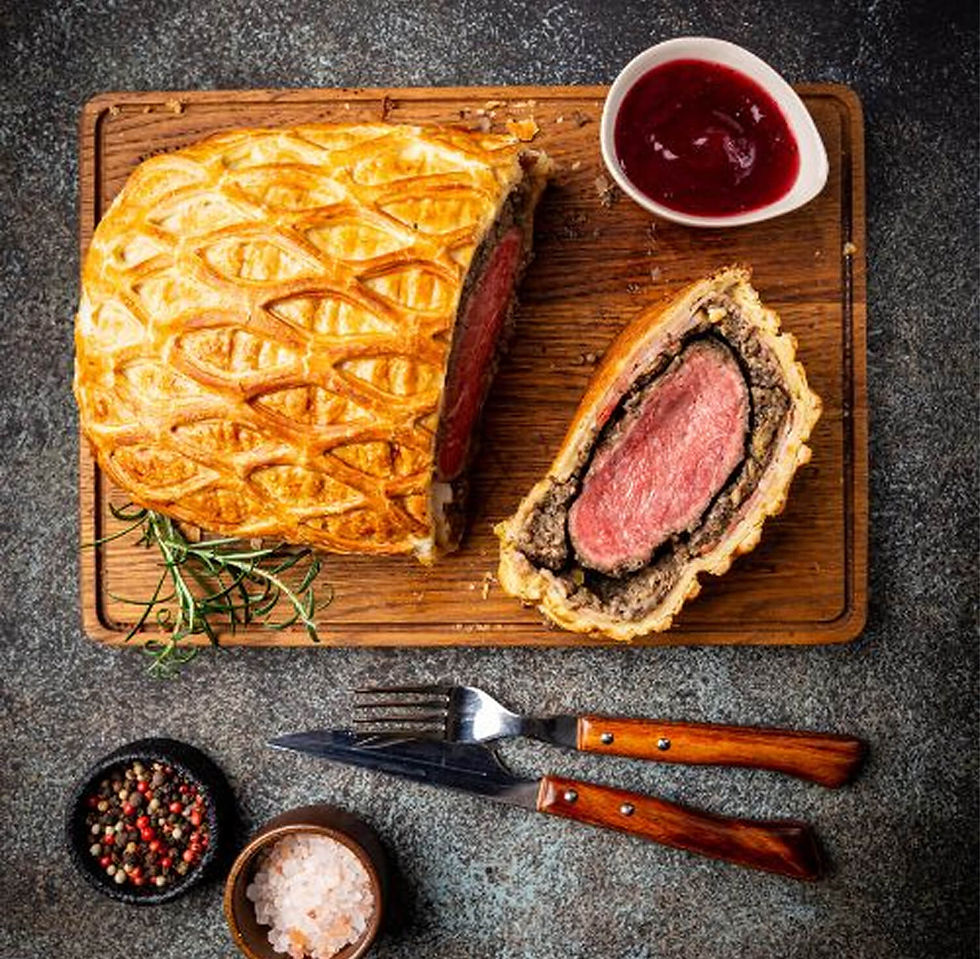Beat the Heat with Cold Soup
- Jul 21, 2023
- 4 min read

There is something very comforting about a steaming bowl of soup on a cold, snowy day. But, when the weather sizzles and you crave something cool and refreshing, a bowl of cold soup will satisfy even the most wilted appetite. During the dog days of summer, you can make cold soup from just about any fruit or veggie that is in season. These “smoothies in a bowl” can be served as an appetizer at the beginning of an elegant summer dinner or as a main course. Many chilled fruit soups are served as a dessert.
Gazpacho is considered the king of cold soups and is one of my family’s favorites. This dish originated in Andalucia in southern Spain and was adapted from a medieval recipe for ajo blanco, or “white gazpacho”, made from stale bread, olive oil, garlic, ground almonds and vinegar. After tomatoes and peppers were introduced to Spain from the New World, the Spaniards added them to the “white gazpacho”, creating a puréed “salad-soup.”
If you’ve never made cold soup and want to serve your family or guests the very best, there are some important factors to consider. Unlike hot soups where you can often get away with using under-ripe or overripe ingredients, cold soups are best made with fruits and veggies at the peak of their ripeness. Therefore, it is important to be extra selective when shopping.
Hot soups or stews often taste the best the day after they’re prepared. Cold soups, on the other hand, should be eaten within a few hours of preparation. In addition, seasoning cold soups can be a bit tricky. Cold soups often require more seasoning because cold temperatures can muffle the taste. It’s best to adjust their seasoning after they are completely chilled. Also, once seasoned, cold soups become spicier the longer they sit in the refrigerator; therefore, it’s best not to keep these soups in the refrigerator more than 12 hours before serving.
Cold soups are best served in chilled soup bowls or mugs. Place the dish or mug in the freezer for 10 to 15 minutes. If you plan to use your fine china or crystal, take extra precaution. Chill china or crystal in the refrigerator for 20 to 30 minutes.
Following is my family’s favorite preparations for gazpacho.
Carol Ann’s Gazpacho Serves 4 to 6
2 pounds tomatoes, peeled, seeded, and chopped 1 red bell pepper, chopped with stems, seeds, and membranes removed 1 green bell pepper, chopped with stems, seeds, and membranes removed 1 cucumber, peeled and chopped ¼ red onion, chopped 1 tablespoon minced garlic 2 tablespoons olive oil 1 tablespoon white wine vinegar ½ to 2 teaspoons sea salt ½ teaspoon freshly ground black pepper Pinch of red pepper flakes 1 cup crushed ice In a large bowl, place tomatoes, red and green bell pepper, cucumber, red onion, and garlic. In a food processor or blender, purée vegetables. Transfer the puréed vegetable mixture to a large bowl. Add olive oil, white wine vinegar, salt, pepper, and red pepper flakes and stir to combine. Add crushed ice and stir to combine. Cover with plastic wrap and refrigerate for at least 1 hour or up to 4 hours, or until soup is icy cold. Once soup is chilled, taste and season with salt and pepper if necessary. For the garnish:
You can garnish this soup with whatever you prefer, but the following are my favorites: 1 tablespoon olive oil 1 ½ cups stale French baguette, cut into ¼-inch cubes 2 to 3 green onions, thinly sliced
1 avocado, diced Crème fraiche
In a small skillet, place 1 tablespoon olive oil over medium heat. When olive oil sizzles, add bread cubes and cook, stirring, until golden, about 2 to 3 minutes. Remove and transfer to paper towels to cool. Croutons can be prepared 3 hours ahead. Store uncovered at room temperature. To serve: Ladle chilled soup into soup bowls. Garnish soup with croutons, green onions, avocado, and a dollop of crème fraiche. Serve immediately.
Cooking tip: To peel tomatoes, cut an X on the top. Drop them into boiling water for about 20 to 30 seconds. Remove with a slotted spoon. Immediately plunge into cold water to retard cooking. Peel. Shopping for tomatoes: Select firm and plump tomatoes. Do not buy pale, spotted, or mushy specimens. Avoid tomatoes with blemishes or cracks. Color is a good indicator of freshness. Pick brightly colored tomatoes. My father taught me to shop with my nose. Smell the stem end of the tomato. If it’s ripe, it will smell like a tomato. Ripe tomatoes should give slightly when pressed. Storing tomatoes: Treat tomatoes gently. Place only ripened tomatoes in the refrigerator. Cool temperatures slow the ripening process. To ripen, place tomatoes at room temperature stem side down. To hasten the ripening process, place tomatoes in a paper bag and keep at room temperature. Shopping for bell peppers: Look for fresh, firm peppers that are bright and thick-fleshed with a firm green calyx and stem. Bell peppers should feel heavy for their size. Immature bell peppers are soft, pliable, thin-fleshed, and pale in color. Do not buy bell peppers with wrinkled skin or any soft or brown spots.
Shopping for cucumbers: Look for cucumbers that are firm and well-shaped with deep green color. Do not buy yellowing, puffy, or shriveled cucumbers. Check for soft spots or soft ends, which is an indication of spoilage. The flesh of cucumbers should be pale green. Yellow flesh indicates they have started to decay.
Carol Ann
Carol Ann Kates is the award-winning author of cookbook, Secret Recipes from the Corner Market and Insider Grocery Shopping Secrets. She’s an expert in how to shop, select, and store produce for maximizing home cooking outcomes and minimizing time and money spent. As a former supermarket and deli operator, Carol Ann shares grocery-insider wisdom—the same expertise you used to receive when patronizing a mom-and-pop establishment. Contact her at CarolAnn@CarolAnnKates.com and explore her website, www.CarolAnnKates.com.
Copyright 2023 All Rights Reserved Carol Ann Kates
1
Searing the Beef
Sear beef fillets on high heat for 2 minutes per side to form a golden crust. Let it cool before proceeding to keep the beef tender.
1
Searing the Beef
Sear beef fillets on high heat for 2 minutes per side to form a golden crust. Let it cool before proceeding to keep the beef tender.
1
Searing the Beef
Sear beef fillets on high heat for 2 minutes per side to form a golden crust. Let it cool before proceeding to keep the beef tender.
1
Searing the Beef
Sear beef fillets on high heat for 2 minutes per side to form a golden crust. Let it cool before proceeding to keep the beef tender.
Notes



1
Season the good fresh beef fillets with salt and black pepper. Heat olive oil in a pan over high heat and sear the fillets for 2 minutes per side until it fully browned. Remove the beef from the pan and brush with a thin layer of mustard. Let it cool.



1
Season the good fresh beef fillets with salt and black pepper. Heat olive oil in a pan over high heat and sear the fillets for 2 minutes per side until it fully browned. Remove the beef from the pan and brush with a thin layer of mustard. Let it cool.



1
Season the good fresh beef fillets with salt and black pepper. Heat olive oil in a pan over high heat and sear the fillets for 2 minutes per side until it fully browned. Remove the beef from the pan and brush with a thin layer of mustard. Let it cool.



1
Season the good fresh beef fillets with salt and black pepper. Heat olive oil in a pan over high heat and sear the fillets for 2 minutes per side until it fully browned. Remove the beef from the pan and brush with a thin layer of mustard. Let it cool.
Instructions
Quality Fresh 2 beef fillets ( approximately 14 ounces each )
Quality Fresh 2 beef fillets ( approximately 14 ounces each )
Quality Fresh 2 beef fillets ( approximately 14 ounces each )
Beef Wellington

Beef Wellington
Fusion Wizard - Rooftop Eatery in Tokyo
Author Name

Beef Wellington is a luxurious dish featuring tender beef fillet coated with a flavorful mushroom duxelles and wrapped in a golden, flaky puff pastry. Perfect for special occasions, this recipe combines rich flavors and impressive presentation, making it the ultimate centerpiece for any celebration.
Servings :
4 Servings
Calories:
813 calories / Serve
Prep Time
30 mins
Prep Time
30 mins
Prep Time
30 mins
Prep Time
30 mins










Comments